Travels Through Historical Fiction: The White Lady
 If readers saw the film version of The English Patient, they may remember that the opening scene showed the main characters in a desert cave marveling at drawings depicting humans and animals painted on the walls. While those cave paintings were in northern Africa, there are cave paintings in southwestern Africa that are just as dramatic and interesting. One in particular is a major tourist attraction and well worth the trek through mountainous desert terrain to see it.
If readers saw the film version of The English Patient, they may remember that the opening scene showed the main characters in a desert cave marveling at drawings depicting humans and animals painted on the walls. While those cave paintings were in northern Africa, there are cave paintings in southwestern Africa that are just as dramatic and interesting. One in particular is a major tourist attraction and well worth the trek through mountainous desert terrain to see it.
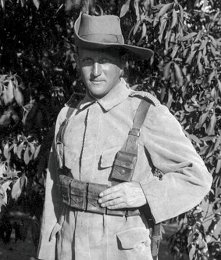
Reinhard Maack
On a January evening in 1917, a topographer and a cartographer took shelter for the night under a rocky overhang on Brandberg Mountain, the highest point in German West Africa (now Namibia). When they awoke the next morning, they discovered they had slept under a wall covered in beautifully rendered Bushman drawings, of which one figure stood out from the rest. It was a human figure whose lower body and limbs were painted white.
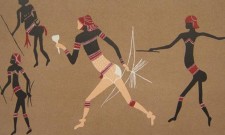
Maack’s 1930 painting of the White Lady based on his 1917 sketch.
Reinhard Maack, the topographer, made a sketch of the paintings and noted in his diary, “The Egyptian Mediterranean style of all the figures is surprising.” From there, the pair continued their task of surveying the mountain. Maack would not realize for some years the effect his sketches and diary comments would have on the cave drawing that became known as the White Lady.
The misinterpretation of Maack’s discovery began in 1929 with French priest, archeologist, and Chairman of Pre-History at College de France, Abbe Henri Breuil (1871-1961). Breuil was given a copy of Maack’s sketches while on a visit to Cape Town. Breuil, a recognized expert on European rock art, theorized that the figure central to the drawings was female. He based his conclusion on his knowledge of drawings of female athletes on the ancient walls of King Minos’s palace on Crete. To justify his conclusion, he posited that a small group of ancient mariners from the eastern Mediterranean traveled to the southern African coast and on to the interior where Brandberg rises up from the desert. He believed these travelers were responsible for the Maack cave drawings. While it was certainly possible for Mediterranean sailors, perhaps the Phoenicians, to have reached the coast of present day Namibia, there is no evidence they did so. The true artists are now known to have been ancient Bushmen native to the area. The White Lady, as the cave is still known today, is not the only cave drawing in the Brandberg area; it is simply the most famous. Brandberg is home to over 1000 rock shelters or caves and 45,000 individual drawings.
Unfortunately, the paintings are not as vibrant as they were in Maack’s time. For many years, tourists were allowed to pour water over the drawings to enhance the colors for photography, which damaged them, but did not destroy them. The cave proved to be one of the most fascinating things I’ve seen. As I observed the human and animal figures, I wondered if the drawings had been created over a rather extensive period because some of them seemed far cruder and more elementary than others. It appeared to me that the earliest artists began with stick figures, while later artists progressed in both perspective and representative skill. Furthermore, the lady looks more like a hunter or warrior to me. Some historians believe that this is most likely the representation of a chieftain or shaman.
Journey with me to the cave and decide for yourself. Are my theories correct?
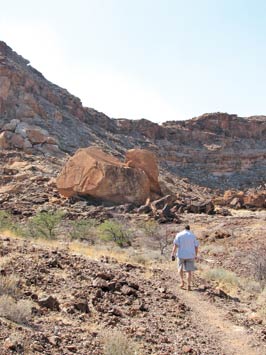
On the path
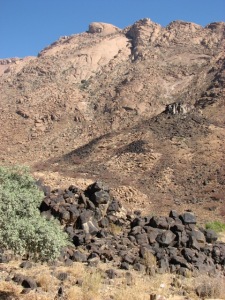
Farther along

The rock shelter

As much of the full display as my camera would capture.

White Lady close up. Note the bow and arrows in his hand.
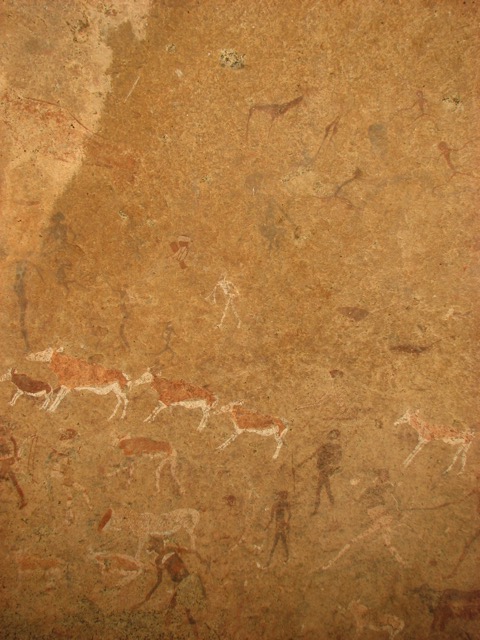
The stick figures are in the upper portion of the photo and are hard to see. My apologies.
And now for our final offering from Africa, two books that I promise will delight the hearts of readers of historical fiction:
 With unsettling beauty and intelligence, Michael Ondaatje’s Booker Prize-winning novel traces the intersection of four damaged lives in an abandoned Italian villa at the end of World War II.The nurse Hana, exhausted by death, obsessively tends to her last surviving patient. Caravaggio, the thief, tries to reimagine who he is, now that his hands are hopelessly maimed. The Indian sapper Kip searches for hidden bombs in a landscape where nothing is safe but himself. And at the center of his labyrinth lies the English patient, nameless and hideously burned, a man who is both a riddle and a provocation to his companions—and whose memories of suffering, rescue, and betrayal illuminate this book like flashes of heat lightning.
With unsettling beauty and intelligence, Michael Ondaatje’s Booker Prize-winning novel traces the intersection of four damaged lives in an abandoned Italian villa at the end of World War II.The nurse Hana, exhausted by death, obsessively tends to her last surviving patient. Caravaggio, the thief, tries to reimagine who he is, now that his hands are hopelessly maimed. The Indian sapper Kip searches for hidden bombs in a landscape where nothing is safe but himself. And at the center of his labyrinth lies the English patient, nameless and hideously burned, a man who is both a riddle and a provocation to his companions—and whose memories of suffering, rescue, and betrayal illuminate this book like flashes of heat lightning.
 The third of Bartle Bull’s Africa sagas: Set in 1935, with Mussolini”s armies marchin g to Ethiopia, we follow the separate and collective fates of a memorable cast of characters in Cairo and East Africa. Adventurers and heiresses, political intrigue and romance combine in A Cafe on the Nile.
The third of Bartle Bull’s Africa sagas: Set in 1935, with Mussolini”s armies marchin g to Ethiopia, we follow the separate and collective fates of a memorable cast of characters in Cairo and East Africa. Adventurers and heiresses, political intrigue and romance combine in A Cafe on the Nile.
Once again, Linda, I am fascinated by your post. I saw some cave drawing in the American southwest years ago, but I would imagine these are much older.
LikeLiked by 2 people
A great post, and the pictures are a real treat; thanks! Thanks also about your comments about The English Patient; I have always meant to read that, and am now resolved to do so.
LikeLiked by 2 people
Thank you, Mark! Always a pleasure to have a fellow author of historical fiction drop by!
LikeLike
Wonderful morning reading, Linda 🙂 So interesting to see different perspectives on the drawings …
LikeLiked by 2 people
Thank you, Lo!! Africa was never on my bucket list, but I’m glad to have seen it.
LikeLike
Great read, Linda. It makes me curious to know more 🙂
LikeLiked by 1 person
Thank you for stopping by, BC!! It was a fascinating place!
LikeLike
Fascinating! How wonderful to see your own pictures of the drawings.
LikeLiked by 1 person
It was an amazing experience!
LikeLike
Reblogged this on Pink Fuzzy Slippers Authors.
LikeLike
I was engrossed in the pictures and post. I hope you don’t mind, but since you had a Reblob button displayed, I reblogged to the Pink Fuzzy Slippers Writers, a group of authors with whom I’ve blogged for years. If you’d prefer not, please let me know and I will remove it immediately! Thanks for an enjoyable read. I’ll check back in the event you want the post removed.
LikeLiked by 1 person
Hi Linda, I am delighted to share my work! I am so glad that you liked the post enough to share it on your blog. Re-blogging is just fine with me as long as History Imagined and I are credited as the original source and author. I hope your readers enjoy the post!
LikeLiked by 2 people
Here’s the link, so you can visit: https://pinkfuzzyslippersauthors.wordpress.com/. It reblogs exactly as you posted. Thanks, Linda.
LikeLike
I enjoyed this!
LikeLike
I am so glad you did, Mary!! Thank you for dropping by!
LikeLike